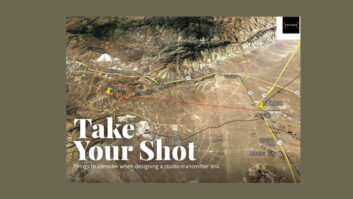There once was a clear line demarcating broadcasting and cinema. That line has blurred at a rapidly increasing pace over the last few years with the increased usage of digital material and procedures in both industries.
Suffice to say 2007 might be remembered as the year when the line ceased to exist.
NAB2007 attendees will once again be treated to a “Digital Cinema Summit,” Saturday and Sunday, April 14 and 15.
A co-op between NAB, the Entertainment Technology Center at the University of Southern California and the Society of Motion Picture and Television Engineers (SMPTE), this year’s summit examines the entire digital production and distribution chain.
BIG SCREEN TECHNIQUES
Saturday’s events, programmed by SMPTE, will include a 1:30 p.m. keynote address from Chris Cookson, chief technology officer for Warner Bros. Entertainment. Cookson will discuss the improvements that digital production techniques have brought to the big screen, which now includes television, and the almost unlimited potential digital production has for the future.
Saturday’s participants will also get to see the latest in 3D techniques, which have come a long way since the introduction of cardboard “glasses” with red and blue (or green) cellophane filters. A session on Sunday will focus on the latest in 3D production techniques.
Also on Saturday, the latest on DC-28 standards will be discussed in “Digital Cinema Standards: A Status Report on DC-28,” 10:15–11 a.m. Wendy Aylsworth, vice president, technology, Warner Bros., will present this session.
The DC-28 standards are an attempt to define digital specifications throughout the production/distribution chain so that all participants, media and equipment can communicate and find the specifications acceptable throughout the chain.
Several sessions will examine workflow challenges. Security concerns are also an issue considering the ease with which digital files can be copied and distributed. But digital production and distribution offer opportunities not even dreamed of years ago.
Speakers will address the possibilities of automated and targeted distribution by tagging files with metadata, improving the tracking and ease of changing content such as switching dialogue languages instantaneously.
There will be several case studies of digital performance in real-world conditions now that digital production and distribution have a few years under their collective belt.
A presenter in 2005, Europe’s WorldScreen project will return to the Digital Cinema Summit with the latest on its efforts to define and answer many of these questions — in a European Union-sponsored dictate. Elfi Berndt with ARRI will moderate “Worldscreen: A European Perspective on D-Cinema,” 3:45–5:30 p.m.
Several other sessions round out Saturday’s events, including “Breakfast Toast in 3D: Raise Your Glasses,” 8:45–10:15 a.m.; “Workflow Challenges in the Digital Theatre,” 11 a.m.–12: 30 p.m.; and “Digital Intermediates: Process and Progress,” 2–3:45 p.m.
LARGE VS. SMALL VENUES
Sunday’s program, designed by the Entertainment Technology Center at USC, will have a more broad-based design to it.
Starting the day will be a session moderated by the Center’s executive director, David Wertheimer. “From the Digital Theater to the Digital Home,” 9–10:10 a.m., will examine in-depth the prospective differences between content exhibition at large venues (huge, highly detailed picture with little interactivity) and exhibition at a digital home theater (lesser picture, but possible heavy interactivity with a PC) and how to create a single product to handle this and more.
Several of Sunday’s sessions will look at the practical concerns of digital distribution. Security will be a major topic in “In-Theater Piracy – Foiling the New Cat Burglars,” 10:10–10:50 a.m., with Mike Robinson, vice president and director, U.S. Anti-Piracy Motion Picture Association of America (MPAA) moderating the session.
The final session of the day, “From Capture to Master – Case Study,” 3:50–5 p.m., will be a case study in creating a digital film from scratch. All aspects, from basic production to editing/post production through final delivery and exhibition, will be studied as to how it was maintained in the digital realm. Leon Silverman, executive vice president, Kodak – Laser Pacific, will moderate the session.
Other Sunday sessions include “Pragmatic Solutions to Delivery Issues – Recommendations from ISDCF,” 11:05–11:45 a.m.; “The Digital Cinema Rollout – Scrutinizing the Picture,” 11:45 a.m.–12:25 p.m.; “Up to Date with DCI,” 12:25–12:45 p.m.; “3D Movie Making – New Dimensions in Film Production,” 1:45–2:55 p.m.; and “Shoring Up the Digital Pipeline – the ASC Blueprint,” 2:55–3:35 p.m.












